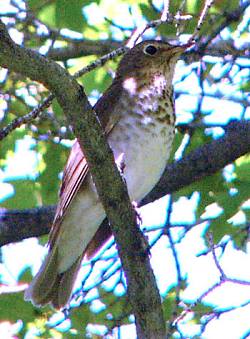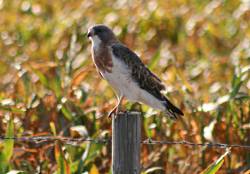
Catharus ustulatus
Copyright © 2004 Jim Bailey
 Swainsons Hawk
Swainsons Hawk
Buteo swainsoni
Copyright © 2010 Eric Peterson
What links this melodious thrush of northern Utah forests
(Kevin Colver: Song Birds of Yellowstone)
with a hawk that soars over farms, range lands and prairies in western North America?
Both Swainson’s Thrush and Swainson’s Hawk are named after the 17th century self-taught British naturalist, William Swainson. He was a contemporary of John James Audubon. Like Audubon, Swainson was a passionate solo collector, taxidermist and skilled illustrator of birds. Unlike Audubon, Swainson’s single intensive field expedition took him far to the south, sailing to eastern Brazil. During his two year stay, he amassed a collection of 20,000 animal specimens, including 760 bird skins. Swainson ultimately named 20 species new to science. Although he never visited North America, he nonetheless co-authored an encyclopedic four volume treatise about North America’s fauna.
Swainson’s Hawk and Swainson’s Thrush share another similarity, this one biological. Both birds migrate long distances to escape winter’s cold and hunger. Swainson’s Thrush winters in balmy tropical forests of South America. Swainson’s Hawk soars farther, all the way to the arid Argentine pampas. There this large slender hawk dines mostly on big flying insects, particularly grasshoppers and even dragonflies. Swainson’s Hawks migrate in groups, often along regular corridors. Every September, Hawkwatch volunteers and hardy birders have reported hundreds of Swainson’s Hawks rocketing past the Wellsville Mountains of northern Utah, flying amid several thousand migrating raptors of all kinds.
Birds migrate to avoid the snow, cold and lean times of northern winters. Migration poses natural risks, of course. Hawkwatch ornithologists also suspect that widespread use of two deadly organophosphate insecticides on Argentine crops kills many insect-eating Swainson’s Hawks. The plow, pavement and subdivisions have also reduced this hawk’s historic northern range, especially in California. In addition, foolish people still shoot this relatively tame hawk, not caring that its diet of rodents and grasshoppers benefits our farmers and ranchers.
Professional disappointments drove the quarrelsome William Swainson south as well, to New Zealand, where he died in anonymity. His namesakes, Swainson’s Hawk and Swainson’s Thrush, live on to cross and recross the equator in pursuit of perpetual summer and the feast it provides.
This is Linda Kervin for Bridgerland Audubon Society.
Credits:
Pictures: Swainson’s Hawk, Courtesy and Copyright © 2010 Eric Peterson, as found on utahbirds.org
Swainson’s Thrush, Courtesy and Copyright © 2004 Jim Bailey, as found on utahbirds.org
Bird Recordings: Kevin Colver https://wildstore.wildsanctuary.com/collections/special-collections
Text: Jim Cane, https://bridgerlandaudubon.org/
Voice: Linda Kervin https://bridgerlandaudubon.org/
Additional Reading:
Swainson’s Hawk, Fieldguide, Utah Division of Wildlife Resources, Utah Department of Natural Resources, State of Utah, https://fieldguide.wildlife.utah.gov/?species=buteo%20swainsoni
Swainson’s Hawk, All About Birds, The Cornell Lab of Ornithology, https://www.allaboutbirds.org/guide/Swainsons_Hawk/overview
Swainson’s Thrush, Fieldguide, Utah Division of Wildlife Resources, Utah Department of Natural Resources, State of Utah, https://fieldguide.wildlife.utah.gov/?species=catharus%20ustulatus
Swainson’s Thrush, All About Birds, The Cornell Lab of Ornithology, https://www.allaboutbirds.org/guide/Swainsons_Thrush/
